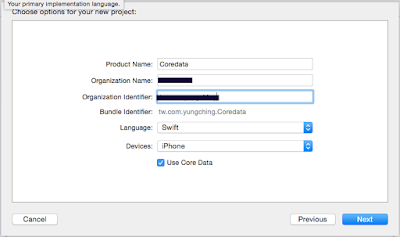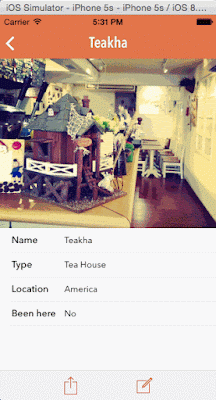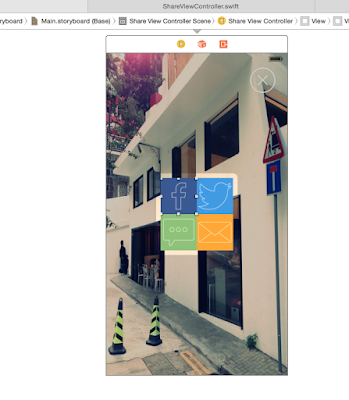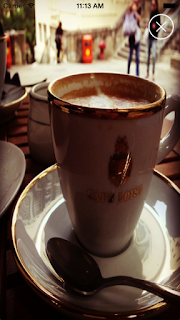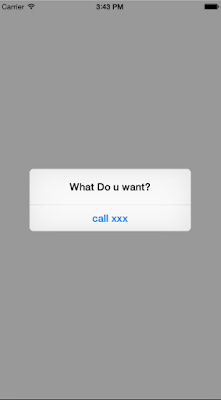基本上有操作過.NET Entity物件的話,這邊的概念幾乎都雷同,最後補上完整的程式碼 ```swift
import UIKit
import CoreData
class ViewController: UIViewController , UITableViewDelegate , UITableViewDataSource, UINavigationControllerDelegate ,NSFetchedResultsControllerDelegate , UIImagePickerControllerDelegate{
@IBOutlet weak var tableview: UITableView!
var friends : [Friend] = []
var fetchRequestController:NSFetchedResultsController!
@IBOutlet weak var NameTextField: UITextField!
@IBOutlet weak var TelTextField: UITextField!
@IBOutlet weak var PicImageView: UIImageView!
@IBOutlet weak var YesButton: UIButton!
@IBOutlet weak var NoButton: UIButton!
override func viewDidLoad() {
super.viewDidLoad()
//讀取Friend的Entity
var fetchRequest = NSFetchRequest(entityName: "Friend")
//排序方式用name這個欄位
let sortDescriptor = NSSortDescriptor(key: "name", ascending: true)
fetchRequest.sortDescriptors = [sortDescriptor]
if let managedObjectContext = (UIApplication.sharedApplication().delegate as AppDelegate).managedObjectContext{
fetchRequestController = NSFetchedResultsController(fetchRequest: fetchRequest, managedObjectContext: managedObjectContext, sectionNameKeyPath: nil, cacheName: nil)
//delegate設定為自己時,當新增修改刪除SQLite的資料時會呼叫以下事件
//controllerWillChangeContent()
//controller(_:didChangeObject:atIndexPath:forChangeType:newIndexPath:)
//controllerDidChangeContent(_:)
fetchRequestController.delegate = self
var e:NSError?
var result = fetchRequestController.performFetch(&e)
friends = fetchRequestController.fetchedObjects as [Friend]
if result != true{
println(e?.localizedDescription)
}
}
}
override func didReceiveMemoryWarning() {
super.didReceiveMemoryWarning()
// Dispose of any resources that can be recreated.
}
func tableView(tableView: UITableView, cellForRowAtIndexPath indexPath: NSIndexPath) -> UITableViewCell {
let identifier = "cell"
var cell = tableView.dequeueReusableCellWithIdentifier(identifier) as customCell
cell.nameLabel.text = friends[indexPath.row].name
cell.telLabel.text = friends[indexPath.row].tel.stringValue
cell.picImageView.image = UIImage(data: friends[indexPath.row].picture)
cell.marryLabel.text = friends[indexPath.row].marry.boolValue ? "YES" : "NO"
return cell
}
func tableView(tableView: UITableView, numberOfRowsInSection section: Int) -> Int {
return friends.count
}
@IBAction func MarryButtonClick(sender: AnyObject) {
YesButton.backgroundColor = (sender as UIButton == YesButton) ? UIColor.redColor() : UIColor.lightGrayColor()
NoButton.backgroundColor = (sender as UIButton == NoButton) ? UIColor.redColor() : UIColor.lightGrayColor()
}
@IBAction func SelectPictureClick(sender: AnyObject) {
let imagePicker = UIImagePickerController()
imagePicker.allowsEditing = false
imagePicker.sourceType = UIImagePickerControllerSourceType.PhotoLibrary
imagePicker.delegate = self
//顯示挑選圖片的視窗
self.presentViewController(imagePicker, animated: true, completion: nil)
}
func imagePickerController(picker: UIImagePickerController, didFinishPickingMediaWithInfo info: [NSObject : AnyObject]) {
PicImageView.image = info[UIImagePickerControllerOriginalImage] as? UIImage
PicImageView.contentMode = UIViewContentMode.ScaleAspectFill
PicImageView.clipsToBounds = true
//關閉挑選圖片的視窗
dismissViewControllerAnimated(true, completion: nil)
}
@IBAction func SaveClick(sender: AnyObject) {
if let manageObjectContext = (UIApplication.sharedApplication().delegate as AppDelegate).managedObjectContext{
var friend = NSEntityDescription.insertNewObjectForEntityForName("Friend", inManagedObjectContext: manageObjectContext) as Friend
friend.name = NameTextField.text
friend.tel = TelTextField.text.toInt()
friend.marry = (YesButton.backgroundColor == UIColor.redColor()) ? true : false
friend.picture = UIImagePNGRepresentation(PicImageView.image)
var e:NSError?
if manageObjectContext.save(&e) != true{
println("error: \(e?.localizedDescription)")
return
}
}
}
//資料庫準備更新了
func controllerWillChangeContent(controller: NSFetchedResultsController) {
tableview.beginUpdates()
}
func controller(controller: NSFetchedResultsController, didChangeObject anObject: AnyObject, atIndexPath indexPath: NSIndexPath?, forChangeType type: NSFetchedResultsChangeType, newIndexPath: NSIndexPath?) {
switch type{
case .Insert:
tableview.insertRowsAtIndexPaths([newIndexPath!], withRowAnimation: UITableViewRowAnimation.Fade)
case .Delete:
tableview.deleteRowsAtIndexPaths([indexPath!], withRowAnimation: UITableViewRowAnimation.Fade)
case .Update:
tableview.reloadRowsAtIndexPaths([indexPath!], withRowAnimation: UITableViewRowAnimation.Fade)
default:
tableview.reloadData()
}
friends = controller.fetchedObjects as [Friend]
}
func controllerDidChangeContent(controller: NSFetchedResultsController) {
tableview.endUpdates()
}
}

